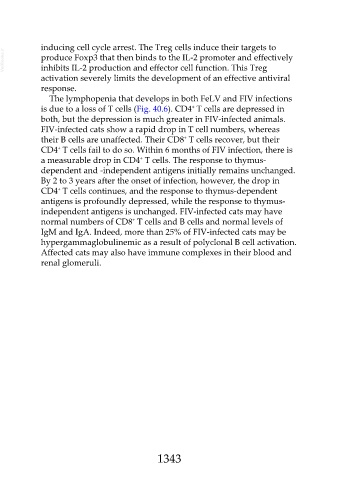Page 1343 - Veterinary Immunology, 10th Edition
P. 1343
inducing cell cycle arrest. The Treg cells induce their targets to
VetBooks.ir produce Foxp3 that then binds to the IL-2 promoter and effectively
inhibits IL-2 production and effector cell function. This Treg
activation severely limits the development of an effective antiviral
response.
The lymphopenia that develops in both FeLV and FIV infections
+
is due to a loss of T cells (Fig. 40.6). CD4 T cells are depressed in
both, but the depression is much greater in FIV-infected animals.
FIV-infected cats show a rapid drop in T cell numbers, whereas
+
their B cells are unaffected. Their CD8 T cells recover, but their
+
CD4 T cells fail to do so. Within 6 months of FIV infection, there is
+
a measurable drop in CD4 T cells. The response to thymus-
dependent and -independent antigens initially remains unchanged.
By 2 to 3 years after the onset of infection, however, the drop in
+
CD4 T cells continues, and the response to thymus-dependent
antigens is profoundly depressed, while the response to thymus-
independent antigens is unchanged. FIV-infected cats may have
+
normal numbers of CD8 T cells and B cells and normal levels of
IgM and IgA. Indeed, more than 25% of FIV-infected cats may be
hypergammaglobulinemic as a result of polyclonal B cell activation.
Affected cats may also have immune complexes in their blood and
renal glomeruli.
1343

